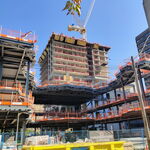It's presumptive to assume the SUV was travelling any faster than traffic does on University when it's not clogged. Don't forget that the damage displayed on both the SUV and LRV is the product of vectored forces, which tends to multiply the impact damage of soft metal shells.
The real question is how the Flexity got "knocked" so far off of directional impetus. And the answer is probably it wasn't. The front right wheel of the SUV *appears* to have gotten lodged under the frontal frame member of the Flexity. It wasn't the lateral impact that dislodged that tram so seriously, it was the wheel lodged under the frame member. The Flexity was *castored* laterally by the SUV front right wheel as well as by some imparted lateral inertia from the impact. Remember, the SUV shows lateral impact, the tram very little impact damage save for broken plastic skirts. The SUV would have been able to deflect the tram sideways with the engaged momentum.
The Flexity weighs over 48K-kg. Think about it. Most of the force was from forward motion of the LRV, the side of the SUV clearly shows that. It also shows a broken right axle arm with the wheel tilted outward, not inward, the opposite of what it would be if impacted without the top of the wheel being jammed under the LRV frame.
The front segment of the LRV *rode* that wheel to the right, and in doing so, lifted the front truck to derail itself where normally it wouldn't have budged laterally save for the wheel flanges of the front-most bogie hard against the inside of the rail-head.
Read the report I linked earlier. Or not.
http://onlinepubs.trb.org/onlinepubs/IDEA/FinalReports/Transit/Transit77.pdf
What happened is a known issue with LRV's especially high-floor ones, but also on low-floor ones like the Flexity where some-one wasn't thinking when they placed the *fixed* hard bumper as high as they did. Ostensibly this was to clear the coupler, which btw, is how the bumper being developed attaches. This was an accident waiting to happen, and will again, most likely with grave consequences.
The vast majority of LRV accidents occur with motor vehicles and cyclists/pedestrians. Collisions where the LRV overrides an automobile are all too common, which can lead to negative consequences
The first cop cleared to make a comment to the press stated: (gist) "It's incredibly lucky pedestrians weren't hit or killed".
Think about that, and think about what King is supposed to be, and then consider that one of the abject safety shortcomings of the Flexity is easily fixed, a known and defined issue, and other manufacturers (Siemens) are not only participating, but fixes are being made available to all manufacturers, at least in North America. Many LRVs are headed back to the factory, it would be an excellent opportunity to adapt them.
There are approximately 1,000 high floor LRV cars in North America that could all benefit from this bumper system technology. They could be retrofitted quickly and brought up to modern road vehicle crashworthiness standards without the need for procuring entirely new cars with enhanced crash safety capabilities. The goal is to pursue these and other markets worldwide.
There is *no way* buses, for example, would be allowed on Cdn roads with a front-end design like we're putting on LRVs. Toronto is exceptional in using a design primarily meant by the German design team to be used on their own RoWs.
This will be a story in the Toronto press in a few days. Streetcars are now covered under the MoT provincial regs, not the Railway Act any more. It's past time for the road safety regulations to be applied. For the benefit of all concerned.
The research paper talks of the damage to pedestrians as much as it does vehicular road traffic. Again, think King Street, and what it's supposed to become. Today's accident was a very lucky warning.
{{...the sound of crickets tapping their Presto Cards....}}




